Revell AG 1/72 Ho-229
|
KIT #: |
04312 |
|
PRICE: |
$15.75 MSRP |
|
DECALS: |
Two options, no swastikas |
|
REVIEWER: |
Shervin Shambayati |
|
NOTES: |
|
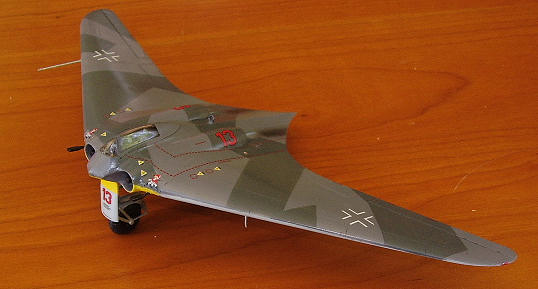
Alternate History
Oberleutnant
Günther Gestal had a lot to think about as his flight approached
Minsk.
Most of it good. It had been eleven months since the July 20 coup had overthrown
Adolf Hitler and brought to power the Committee. With Beck as the President, the
military was in the hands of professionals again and with it had come the
“Miracle.”
In the
west, Rommel and von Rundstedt had managed to withdraw the troops in an orderly
fashion to the line of the Seine
and in the process had managed to inflict crippling losses on the British and to
a lesser extent on the Americans. This had forced the Brits and Americans to the
table and for the past six months an uneasy truce existed between
Germany
and US and Britain
while the diplomats were negotiating.
In the east, von Manstein was
put in charge of all the forces. Even though
Army
Group
Center
had been annihilated, Manstein had managed to pull Army Group North down from
Leningrad
and the Baltic States
to establish a line of defense behind Nieman anchored at the Baltic and the
Pripet Marshes. Army Group South had pulled behind
Dniester with most
of its heavy equipment and had fought the Soviets there to a standstill. Even
though the Committee had proposed a negotiated peace with the Soviets, the
Soviets had rejected all such offers and continued to fight but with little
success.
With the Nazis gone, many of
the eastern European countries were fighting on the German side against the
Soviets. Pro-German governments in
Poland
and Czechoslovakia
were established and Czechs, Pols and Hungarians were now fighting along with
the Germans against the Russians. Added to this were some Ukrainians and White
Russians who were promised protection by the Germans and now
Germany
had enough troops to man the line from the
Black Sea to the
Baltic with four mobile Corps to plug any gaps and to launch spoiling attacks
against the Russians.
The upside of the truce with
the Brits and the Americans was that the bombing of
Germany
had stopped. This had allowed Albert Speer to completely overhaul and modernize
the German military. The Army was now fully motorized with all mechanized
divisions armed with Panther tanks and supported with self-propelled artillery.
In the
Luftwaffe changes were even more dramatic. Production of Bf.109 and Bf.110 had
stopped and Messerschmitt was now producing Me.262s only. Stukas were out as
well. Instead, all Jabo squadrons were armed with Fw.190Fs and Fw.190Gs. In the
bomber command, all pre-war bombers with the exception of Ju.88 were retired.
Instead Arado Blitz was arming most of the tactical bomber squadrons. Luftwaffe
had also gotten into strategic bombing. Arado E.555 with its massive bomb load
was now used to bomb strategic targets deep into
Russia.
On one night raid in May 1945 they had even managed to hit the Kremlin.
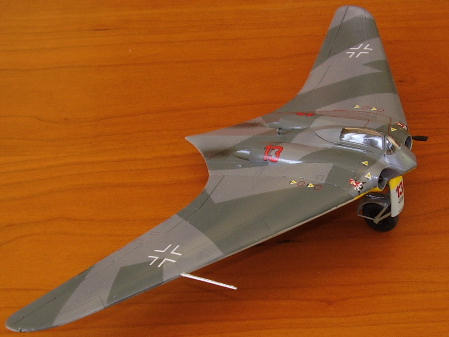 The
Jagdwaffe was practically all jets. The only piston-engine fighter in use was
Fw.190H which had mated DB.605 engine to the Fw.190D airframe. These were used
to fly top cover over the airfields as the new jets came in to land. Me.262s and
He.162s were used to establish air superiority over the battlefield while
Ho.229s were used for escort missions. And that is what Günther was doing now.
The
Jagdwaffe was practically all jets. The only piston-engine fighter in use was
Fw.190H which had mated DB.605 engine to the Fw.190D airframe. These were used
to fly top cover over the airfields as the new jets came in to land. Me.262s and
He.162s were used to establish air superiority over the battlefield while
Ho.229s were used for escort missions. And that is what Günther was doing now.
Recent intelligence indicated
that the Russians were preparing for a summer offensive to break through the
line between Pripet Marshes and Loop of the Nieman, rollup the German army up
the Nieman and rush towards
Warsaw. They were now
bringing up men and equipment. Given the poor state of the roads in
Russia,
it was clear that everything that the Soviet Army’s Belarusian Front needed for
its offensive had to be routed through
Minsk.
To stop the offensive, the Luftwaffe needed to bomb
Minsk’s
rail yards and had to do it in daylight. For this purpose, Luftwaffe had
assigned twelve E.555s and 48 Blitzes, escorted by 120 Me.262s and 48 Ho.229s.
Blitzes and Me.262s were to
take off from the tactical airfields all along the Nieman while E.555s took off
from Warsaw.
Ho.229s had taken off from their special airbase near
Bialystok
and had met up with the E.555s just behind the front line. They were now only 10
minutes away from their targets. If everything went as planned, the Blitzes
would have taken care of most of the flak right about now. The only thing that
Günther, the other Ho.229s and the E.555s would then have to worry about was the
Soviet Meteors.
At 35,000 feet, the jets were untouchable by
anything other than the two dozen or so Gloster Meteors that the Brits had sold
to the Russians. Recently, some of them had jumped some unsuspecting Blitzes
over the front and had downed two of them before Me.262s had shot a couple of
them down and forced the rest to run for cover. This was the first time that
Meteors had appeared this close to the front—yet another indication of the
upcoming offensive.
Günther’s finger four schwarm
was flying ahead and higher than the main formation of the bombers and escorts.
Their job was to breakup any concerted attack by the enemy fighters
As Günther was mulling all
this, the voice of his wingman, Rudolf, came over the radio: “Horido! Aircraft.
Two O’clock
low.”
Günther looked and there they were: ten Meteors in
two V groups of five coming low and fast. Had they spotted Günther and his
schwarm? Günther called on his radio to the group commander informing him that
Meteors were sighted and his schwarm was going to engage them. The group
commander approved his decision and told him that the rest of the group will
stick with the bombers as Günther and his schwarm dealt with the Meteors.
Günther would have liked to have more support but he understood the group
commander’s decision.
All the pilots in the schwarm switched their
radios to the schwarm’s assigned frequency to coordinate their action. He waited
about ten seconds. The Meteors did not climb although they were coming towards
him and the bombers. He called on the radio, “Increase speed and let them pass
under us and then dive on them.”
It was a sunny summer day and
the maneuver was perfect for the situation. Around
noon with the sun
high the Russians would not be able to see his schwarm and he would be coming on
their six O’clock
out of the sun.
As he was churning these thoughts in his head he noticed
something else: plumes of smoke rising up straight ahead. The Blitzes were doing
their job after all and with any luck, some of their Me.262 consorts would be
coming to his aid. However, for now, he had to concentrate on taking on ten
Meteors with his schwarm of four.
The Meteors were nowhere as fast or as
maneuverable as the Ho.229s but their four 20mm cannons did pack a punch and
could easily shred an E.555 with a few well placed hits not to mention what they
could do to a Ho.229. With that in mind, Günther slowly pushed his throttle
forward and his schwarm followed suit. He had to wait for the Meteors to fly
under him. Any second now. But then the Meteors started climbing. They had seen
something but Günther wasn’t sure if it was him or the bombers five miles behind
him.
It was too late to change
plans now. He flipped the trigger cover on his stick. In about five seconds, he
would know if the Meteors were going after him or after the bombers. And there
they were climbing right in front of his schwarm and going for the bombers.
Slight change of plans. Günther banked his Ho.229 hard left and pushed his
throttles all the way with the rest of the schwarm. The response was slightly
delayed but he had become used to this with the jets. As he finished his turn,
he saw the first group of five Meteors shoot up ahead of him. He was at their
seven o’clock.
He pulled his nose up and came on the six o’clock
of the Meteor on the left of the V. He pushed his trigger for a five second
burst. The two high velocity 30mm cannons came to life and riddled the left wing
of the Meteor with their shells. The Meteor’s wing exploded and the rest of the
aircraft went out of control, cartwheeling for a couple of seconds towards the
ground before it too burst into flames. One down.
By this time the rest of the Meteors in the V had
noticed the Ho.229s and took evasive action. What was worse, the second V had
broken off its approach towards the bombers and was climbing to join the fight.
No time think about that now. His finger four schwarm broke up into two flights
of two. Günther and his wingman started chasing after the next Meteor in the
left arm of the V, while the other two planes in his flight turned around to
meet the second V head on.
 The
Meteor driver was good but not as good as Günther and his plane was nowhere near
as fast or as nimble as the Ho.229. As the Meteor broke hard to the right,
Günther turned inside of him and squeezed another burst and the Meteor exploded
instantly. Splash two.
The
Meteor driver was good but not as good as Günther and his plane was nowhere near
as fast or as nimble as the Ho.229. As the Meteor broke hard to the right,
Günther turned inside of him and squeezed another burst and the Meteor exploded
instantly. Splash two.
Günther looked around; the
second group of fighters was busy fending off the other two Ho.229s and was not
a threat yet. He had time to look for the other three planes in the first group.
There they were at his three o’clock,
turning right to join the fight against the other two planes in his schwarm. He
called on his radio to his wingman, “Rudolf hard right and climb. You have the
lead.”
Both planes turned and
climbed rapidly and then they looped and leveled their wings. Rudolf had looped
sooner as planned so when the straightened out they were at
six o’clock high of
the Meteors with Rudolf in the lead and lower and Günther on his port at
eight o’clock and a
little higher. The Meteors had not time to react. Ho.229s used their superior
speed to press the attack. At about 200 meters, Rudolf’s guns came to life and
the right most Meteor fireballed. The other two Meteors turned hard left to
escape the same fate. Automatically, Günther and Rudolf turned left as well with
Günther now pulling into the lead. Both Ho.229s were turning inside the Meteors
and Günther tried for a high deflection shot on the lead Meteor and gave it a
three second burst. The shells sheered the tail off the Meteor and sent it
tumbling to the ground. The last Meteor tried to change direction and turn right
but that brought him right in front of Rudolf’s plane which dispatched it with a
burst from its cannons.
The first group of Meteors
was dealt with in less than 2 minutes. Now Günther looked for the second group
and the other two planes in his schwarm. He could see three Meteors and one
Ho.229 at his 2 o’clock
level. He could only guess at what had happened to the other planes. He had
heard some chatter on the radio during his engagement with the first group but
he was too focused on his own fight to pay attention. The single Ho.229 was
completely on the defensive and was trying to use his superior speed to get out
of the jam but the Meteors were making it hard for him.
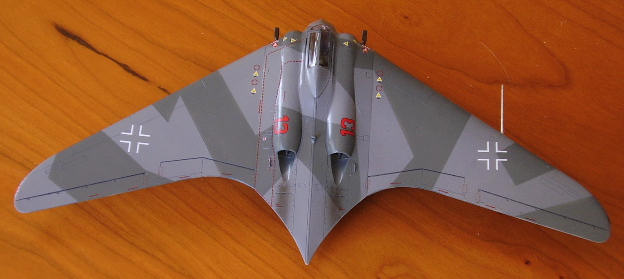 Günther
and Rudolf turned slightly to the right and climbed a little to get on top of
the Meteors. In fifteen seconds they merged. The Meteors were flying in a small
V and where turning with the Ho.229 at times firing short bursts to keep the
Ho.229 in front to the lead plane. Günther could see the Ho.229 belonged to
Gerhard Warhut, a baby-faced Leutnant who, despite his youth, was an excellent
flyer. Günther called on the radio, “Gerhard, on the count of three turn hard
right.”
Günther
and Rudolf turned slightly to the right and climbed a little to get on top of
the Meteors. In fifteen seconds they merged. The Meteors were flying in a small
V and where turning with the Ho.229 at times firing short bursts to keep the
Ho.229 in front to the lead plane. Günther could see the Ho.229 belonged to
Gerhard Warhut, a baby-faced Leutnant who, despite his youth, was an excellent
flyer. Günther called on the radio, “Gerhard, on the count of three turn hard
right.”
Gerhard turned hard right and
the Meteors followed. This brought Günther and Rudolf’s planes at the
six o’clock of the
Meteors. Both of them had clean shots. Günther fired first and took off the left
wing of the Meteor on the left of the V sending it to the ground. He then
climbed up and let Rudolf take the lead. Rudolf fired on the Meteor on the right
of the V and exploded it after a five second burst. The remaining Meteor was
Günther’s. He increased his speed yet again in a shallow dive and let loose with
his cannons. His shells ripped through the cockpit of the Meteor, killing its
pilot. The Meteor started to climb with its cockpit smoking until it stalled and
tumbled to the ground. Günther had shot down five jets in less than five minutes
but he had no time to think about that. The bombers had still not reached
Minsk.
*****
Back at the base he found out what had happened to the fourth
Ho.229 in his flight. Gerhard and Manfred Reiser-- a feldwebel-- had engaged the
second group of Meteors. Gerhard had shot down one of them. Manfred had shot
down the second but as he did so his engines ingested some of the debris and his
aircraft lost power. Gerhard had seen a parachute but Manfred might as well be
dead. The Russians did not treat their prisoners kindly.
The raid
itself was very successful.
Minsk’s rail yards and depots
were smoldering and damaged beyond all repairs. To make matters worse for the
Soviets, the depots and the rolling stocks were all filled with ammunition and
equipment for the upcoming offensive and they were all destroyed. In the air
Soviets were utterly defeated. At the cost of five Me.262s, two Ho.229s and
seven Blitzes, Luftwaffe had destroyed 241 Soviet fighters, including all but
two of the Soviet Meteors. The Soviet offensive was stopped before it started.
And Günther Gestal was a jet ace in a day.
Real
History
Ho. 229 was the brainchild of Reimer and Walter Horten. Horten
brothers were interested in aircraft and aircraft design at an early age. They
were influenced by Dr. Alexander Lippisch whose work eventually led to F-102 and
F-106 delta wings. As such Horten brothers designs were unconventional, focusing
especially on flying wings. Ho.229 was the RLM designation for Horten IX design,
a twin turbojet powered flying wing that the Hortens designed in response to a
demand by Herman Goering for a 1000 km/h aircraft with a range of 1000 km and a
weapon load of 1000 kg.
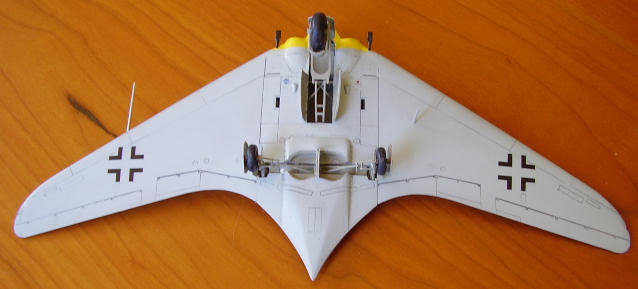 Goering
was impressed by the Horten design and ordered 40 of the aircraft into
production before the aircraft took flight under jet power. The flight tests,
however, validated Goering’s decision. The aircraft speed was 960 km/h and
because of its low drag had a very long range. The aircraft was armed with 2
Mk108 30 mm low velocity canons although at the time Germans were planning for a
high velocity 30 mm canon.
Goering
was impressed by the Horten design and ordered 40 of the aircraft into
production before the aircraft took flight under jet power. The flight tests,
however, validated Goering’s decision. The aircraft speed was 960 km/h and
because of its low drag had a very long range. The aircraft was armed with 2
Mk108 30 mm low velocity canons although at the time Germans were planning for a
high velocity 30 mm canon.
Initial
flight tests were impressive and although the prototype was lost to a
combination of engine fire and unexpected landing gear deployment, killing the
pilot, the production was put on the fast track. Although the aircraft never
achieved production status because of the end of the war, the
US
troops managed to get the hold of one of the prototypes. This aircraft is now at
the National Air and
Space Museum
restoration facility.
This is the latest packaging of Ho.229 by Revell AG. I
believe, this kit was first released in 1990s and is part of the Luft ’46 series
of aircraft that Revell manufactured during that period. This kit consists of
three gray sprues and one clear sprue containing the canopy and the windshield.
The details are finely engraved. There is very little flash but there were a
couple sink marks on the lower wing where the alignment pins are and the
fortunately no ejection pin marks anywhere noticeable.
Decals are offered for two fictitious aircraft
both with geometric upper patterns. The first is the “Red 13” with RLM 74/75/76
colors the other is the “Blue 4” with RLM 81/82 tops and a light aircraft gray
(the illusive RLM 84?) bottom. Both aircraft belong to the fictitious JG400.
This being a German kit, there are no Swastikas.
When I do reviews of kits, I like to point to the problem areas that
I came to instead of giving a blow by blow of the construction. Here are the
problem areas that I found and what I think solutions for them ought to be.
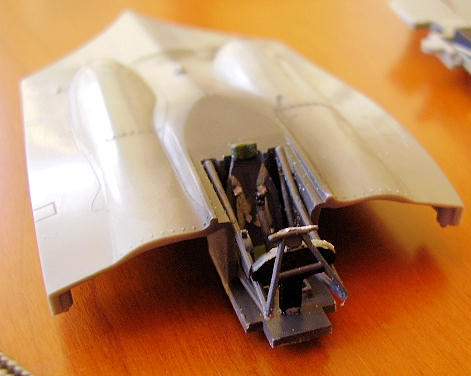 The
cockpit: This consists of the seat assembly (which is the seat, the leg rests
and the stick) the instrument panel with decal for the instrument (no raised
details) and the three parts representing the tubular cage around the cockpit
(two side parts and a part on the front). The problem here is that the side
parts do not have positive lock and you have to guess at their position if you
follow the instructions (like I did). This caused the instrument panel to be put
in a different position and front part of the cage to go on top of it in such a
manner that it prevented the windshield to sit properly later on. That meant
that I had to trim the side bars that protruded from this part in order to have
the windshield fit properly. To avoid this, I recommend that before putting the
side tubes you install the instrument panel. Then line up the aligning pins that
protrude from the front of the tube parts to line them up with the instrument
panel and glue them into place. This should give you proper alignment for these
parts and the front tubing. The floor of the cockpit is also the top of the
front landing gear bay. I did not test fit the part and that caused me to do a
bit of sanding and filling. I think if I had done a test fit and did a little
bit of trimming, I would have gotten a much better fit.
The
cockpit: This consists of the seat assembly (which is the seat, the leg rests
and the stick) the instrument panel with decal for the instrument (no raised
details) and the three parts representing the tubular cage around the cockpit
(two side parts and a part on the front). The problem here is that the side
parts do not have positive lock and you have to guess at their position if you
follow the instructions (like I did). This caused the instrument panel to be put
in a different position and front part of the cage to go on top of it in such a
manner that it prevented the windshield to sit properly later on. That meant
that I had to trim the side bars that protruded from this part in order to have
the windshield fit properly. To avoid this, I recommend that before putting the
side tubes you install the instrument panel. Then line up the aligning pins that
protrude from the front of the tube parts to line them up with the instrument
panel and glue them into place. This should give you proper alignment for these
parts and the front tubing. The floor of the cockpit is also the top of the
front landing gear bay. I did not test fit the part and that caused me to do a
bit of sanding and filling. I think if I had done a test fit and did a little
bit of trimming, I would have gotten a much better fit.
The wings: These are long wings and they had a warp to them.
Take care to align them properly and glue them in sections. I think I did not do
this properly on the port wing and that caused the left wing to require filler
when attaching it to the middle section of the aircraft.
The nose section: This part simply does not fit properly.
Fortunately it joins the main fuselage at a panel line. In order to minimize its
cosmetic affect, I lined up the top of this part with the main fuselage so most
of the bad fit was transferred to the bottom. This also helped the canopy and
the windshield to lineup properly.
I painted the intakes on the nose section Model Master
RLM 75 and the exhausts area on the top fuselage RLM
74.
This allowed me to mask the exhaust and the intakes later without to much
hassle.
Landing Gears: The instructions have you assemble the landing
gear and their attendant arms before installing them. This approach is not to be
taken as the alignment of the arms on the main landing gears is rather tricky.
It is best to install the landing gears before installing the actuating arms to
get proper alignment. I also sanded the alignment keys on the main landing gears
to shorten them and get the “T” at the bottom of the landing gears to join flush
with the landing gear bay. The front landing gear is a nightmare, however, and
it required about an hour of fitting and fiddling to get it quasi right. The
actuating part consists of four parts and they need to be lined up properly.
Also, do not install the front landing gear door that is attached to the landing
gear itself as I did. This adds to the chore of getting landing gear actuating
arm properly aligned.
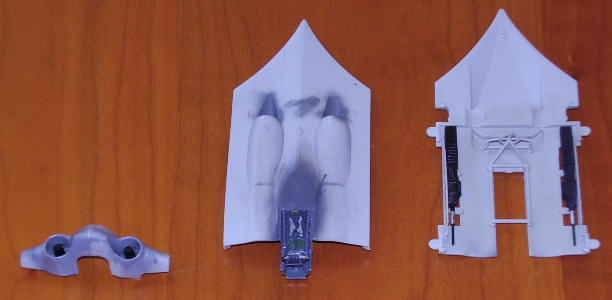 As for the
general sequence of the build was:Cockpit floor, seat, wings, front and back
shock cones and guns, all painted appropriate colors.
As for the
general sequence of the build was:Cockpit floor, seat, wings, front and back
shock cones and guns, all painted appropriate colors.
Compressor face and exhaust fans were hand painted with an old
Humbrol silver metal coat (the tin is twenty years old and it is still the best
paint for hand painting silver).
Side cockpit tubing and front landing gear tubing and wing
attachment piece on the lower fuselage.
Painting of the cockpit and the seat with Tamiya XF-63 (RLM
66) and the landing gears and landing gear bays and inner doors with Gunze RLM
02 (even though the instruction calls for RLM 66 I think but this is a fictional
paint job anyway).
Assembled the wheels.
Painted the wheel hubs and the instrument panel Tamiya XF-18
(Semi-gloss black).
Painted the intake on the nose section RLM 75 and painted the
exhaust section on the upper fuselage RLM 74.
Attached front shock cones to the intake/compressor face parts
and back shock cones to the exhaust fans.
Installed the guns on the lower fuselage, the exhaust
assemblies to the upper fuselage and the intake assemblies to the nose section.
Put the instrument panel decal on and installed the instrument
panel, the seat, the stick and the front tubing.
Attached the fuselage halves.
Attached the nose section.
Attached the wings and puttied the left wing seam. Puttied the
sink marks on the lower wings with Tamiya primer (this is like Mr. Surfacer and
I like it a lot).
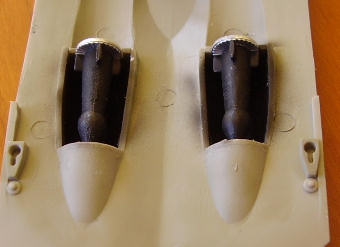 Masked the
exhaust and the intakes.Dipped the windshield and the canopy in Future. After
they were dried, I masked them with Bare Metal foil.
Masked the
exhaust and the intakes.Dipped the windshield and the canopy in Future. After
they were dried, I masked them with Bare Metal foil.
Attached the canopy and the windshield to the fuselage and
sprayed their framing Tamiya XF-63 (RLM 66).
Masked the landing gear bays.
Painted, decaled and weathered the model (See below).
Attached the landing gears and the landing gear doors.
Painted the wing tip lights with Gunze clear red and green
over a base Humbrol silver.
Attached the gun barrels, the pitot tube, the loop
antenna and the IFF antenna.
I had decided to build the “Red 13” without Swastikas (see
alternate history) using the kits decals and painting instructions. This
aircraft is RLM 04 under the nose with RLM 76 lower color and RLM 74/75 in a
geometric pattern for upper colors.
First I painted the nose and the front landing
gear front door with Model Master flat white. After that dried, I painted them
with Tamiya flat yellow. This yellow is not as deep a yellow as RLM 04 but it is
close enough.
After the yellow was dried, I masked the nose and the yellow
section of the landing gear door with Tamiya tape. This was done by first
cutting a very thin strip of tape to mask off the edge of the yellow section so
that I could achieve a straight line while still going over the bumps of the
intakes. Then I masked the rest of the nose. This is a technique that I always
use to achieve straight lines going over curves and bumps.
I then painted the rest of the bottom of the plane
and the outside of the landing gear doors Model Master RLM 76. After that dried
I masked the entire bottom of the aircraft.
For the geometric pattern on the top, I first used
a pencil to roughly outline the pattern. Since I had already painted the exhaust
section RLM 74, I painted that color first using Model Master RLM 74. I then
masked those areas with Tamiya tape. I could have made paper masks from the
pattern in the instruction but I decided that would be too time consuming.
Again, I used thin strips of
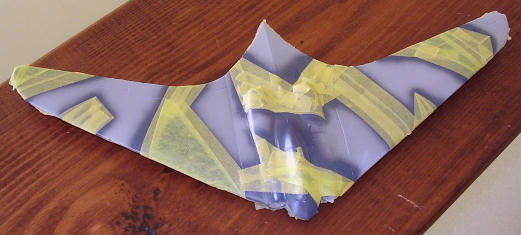 tape to
outline the RLM 74 areas that went over the bumps of the engines and inside the
port exhaust area. One trick to masking these geometric patterns is to cut the
head of the tape diagonally at angle which is less than the angle of the
pattern. So for angles that are greater than 90 degrees, square tip of the tape
would do but for angles less than 90 degrees, you need to cut the tape
diagonally. This process need not be precise since you can overlap the tapes to
form the proper angle.
tape to
outline the RLM 74 areas that went over the bumps of the engines and inside the
port exhaust area. One trick to masking these geometric patterns is to cut the
head of the tape diagonally at angle which is less than the angle of the
pattern. So for angles that are greater than 90 degrees, square tip of the tape
would do but for angles less than 90 degrees, you need to cut the tape
diagonally. This process need not be precise since you can overlap the tapes to
form the proper angle.
With the masking done I painted the rest of the
aircraft Model Master RLM 75. After RLM 75 had dried, I removed the masks. I
noticed some bleed through into the yellow area and under a couple areas on the
top. I touched up these with proper colors.
After this, the model was coated with Tamiya
clear. Recently I had had some cracking problems with Future and have decided to
use Tamiya clear. I cut it 50% with Tamiya thinner and sprayed it on and let it
dry.
After the clear coat had
dried, I applied the decals. These are printed in
Italy,
in register and matt and react extremely well to Microsol and Microset. These
went on without any problem even the large walkway decal.
After the decaling was done, I recoated the model
with Tamiya clear and applied a sludge wash. The exhaust stains were then
applied using Tamiya smoke. After this, a topcoat of Gunze flat clear was
applied and the aircraft was ready for its final bits and pieces (see the order
of the build above).
This was thoroughly enjoyable kit with minimum
amount of filling and sanding. However, the engineering and instructions for
front landing gear and the tube cage in the cockpit and the poor fit of the nose
section makes this model something less than a Tamigawa. As such the grade is a
solid A- and the model is recommended to all but the most inexperienced of
modelers.
http://en.wikipedia.org/wiki/Ho_229
http://en.wikipedia.org/wiki/Horten_brothers
Shervin Shambayati
July 2008
If you would like your product reviewed fairly and fairly quickly , please
contact
the editor or see other details in the
Note to
Contributors.
Back to the Main Page
Back to the Review Index Page 2015






 The
cockpit: This consists of the seat assembly (which is the seat, the leg rests
and the stick) the instrument panel with decal for the instrument (no raised
details) and the three parts representing the tubular cage around the cockpit
(two side parts and a part on the front). The problem here is that the side
parts do not have positive lock and you have to guess at their position if you
follow the instructions (like I did). This caused the instrument panel to be put
in a different position and front part of the cage to go on top of it in such a
manner that it prevented the windshield to sit properly later on. That meant
that I had to trim the side bars that protruded from this part in order to have
the windshield fit properly. To avoid this, I recommend that before putting the
side tubes you install the instrument panel. Then line up the aligning pins that
protrude from the front of the tube parts to line them up with the instrument
panel and glue them into place. This should give you proper alignment for these
parts and the front tubing. The floor of the cockpit is also the top of the
front landing gear bay. I did not test fit the part and that caused me to do a
bit of sanding and filling. I think if I had done a test fit and did a little
bit of trimming, I would have gotten a much better fit.
The
cockpit: This consists of the seat assembly (which is the seat, the leg rests
and the stick) the instrument panel with decal for the instrument (no raised
details) and the three parts representing the tubular cage around the cockpit
(two side parts and a part on the front). The problem here is that the side
parts do not have positive lock and you have to guess at their position if you
follow the instructions (like I did). This caused the instrument panel to be put
in a different position and front part of the cage to go on top of it in such a
manner that it prevented the windshield to sit properly later on. That meant
that I had to trim the side bars that protruded from this part in order to have
the windshield fit properly. To avoid this, I recommend that before putting the
side tubes you install the instrument panel. Then line up the aligning pins that
protrude from the front of the tube parts to line them up with the instrument
panel and glue them into place. This should give you proper alignment for these
parts and the front tubing. The floor of the cockpit is also the top of the
front landing gear bay. I did not test fit the part and that caused me to do a
bit of sanding and filling. I think if I had done a test fit and did a little
bit of trimming, I would have gotten a much better fit.  As for the
general sequence of the build was:Cockpit floor, seat, wings, front and back
shock cones and guns, all painted appropriate colors.
As for the
general sequence of the build was:Cockpit floor, seat, wings, front and back
shock cones and guns, all painted appropriate colors. Masked the
exhaust and the intakes.Dipped the windshield and the canopy in Future. After
they were dried, I masked them with Bare Metal foil.
Masked the
exhaust and the intakes.Dipped the windshield and the canopy in Future. After
they were dried, I masked them with Bare Metal foil.  tape to
outline the RLM 74 areas that went over the bumps of the engines and inside the
port exhaust area. One trick to masking these geometric patterns is to cut the
head of the tape diagonally at angle which is less than the angle of the
pattern. So for angles that are greater than 90 degrees, square tip of the tape
would do but for angles less than 90 degrees, you need to cut the tape
diagonally. This process need not be precise since you can overlap the tapes to
form the proper angle.
tape to
outline the RLM 74 areas that went over the bumps of the engines and inside the
port exhaust area. One trick to masking these geometric patterns is to cut the
head of the tape diagonally at angle which is less than the angle of the
pattern. So for angles that are greater than 90 degrees, square tip of the tape
would do but for angles less than 90 degrees, you need to cut the tape
diagonally. This process need not be precise since you can overlap the tapes to
form the proper angle.